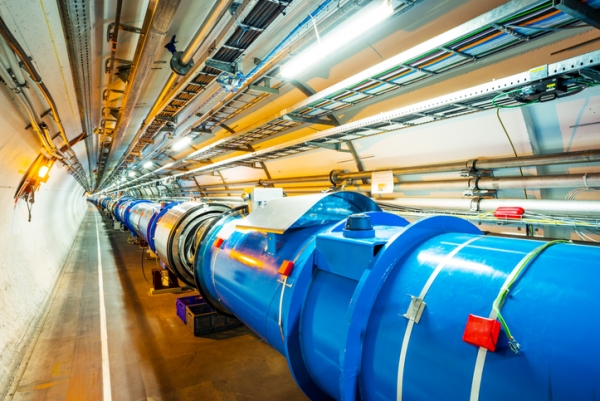Why Care About the Higgs Boson?

Cartoon Higgs boson particle (lineartestpilot, iStockphoto)

Cartoon Higgs boson particle (lineartestpilot, iStockphoto)
How does this align with my curriculum?
| Grade | Course | Topic |
|---|
Physicists are a bit like chefs, except they’re trying to figure out the recipe for the universe.
Imagine you were a master chef who was served a delicious mystery dish. Wouldn’t you try to figure out the recipe? You’d want to know which ingredients were used and how they were combined to produce something so yummy. And wouldn’t you put your guesses to the test in the kitchen? I bet you would!
Physicists are a bit like chefs, but they’re trying to figure out the recipe for the Universe. This recipe would be a mathematical equation. And instead of testing it in a kitchen, researchers use huge underground tunnels like the Large Hadron Collider.

The purpose of these very magnetized and very cold tunnels is to try to copy the conditions that were present when the Universe was born. At that time, highly energized particles were moving at tremendous speeds and colliding with each other.
Inside the Large Hadron Collider, scientists found the Higgs boson hiding in the matter left over after a collision of protons. Physicists had been predicting the existence of the Higgs boson for fifty years. Finding it filled a major gap in our understanding of the Universe. The physicists who first described the particle—Peter Higgs and Francois Englert—won the 2013 Nobel Prize in Physics.
Did you know?
The discovery of the Higgs boson was the result of the biggest and most expensive experiment ever run. Hundreds of mathematicians, physicists and engineers from many different countries collaborated on the project for more than a decade. One journalist suggested it cost $13.25 billion to find.
So what makes the Higgs boson such an important ingredient in the Universe? Like a chef trying to recreate a delicious meal but unable to find a key ingredient, physicists have spent decades trying to understand a property that is essential to our universe. That property is mass.
You could say that mass is what allows our Universe, our entire material world, to exist. But until recently no one was really sure how to account for mass. Or how to explain why different particles have different masses. This meant that no one could really explain the huge diversity of the Universe either!
But now that they know the Higgs boson is real, physicists can finally explain why mass exists. The Higgs boson has unlocked one of the greatest mysteries of all time. It shows us why our world is the way it is.
How does the Higgs boson explain mass?
Until recently, physicists’ recipe for the universe, called the Standard Model, already included all sorts of elementary particles like quarks, leptons, and bosons.
Quarks make up the protons and neutrons found inside an atom’s nucleus. The best-known leptons are the negatively charged electrons outside the nucleus. Bosons account for various energy fields like electricity and light. But none of these particles explain mass.
But with the addition of the Higgs boson to this list, mass can be explained. It turns out that all elementary particles are surrounded by Higgs bosons. These newly-discovered bosons fill up the space between particles. This is called the Higgs field.
Particles like photons encounter no resistance when they move through the Higgs field. This is why they move very fast and have no mass. Other particles, like electrons, encounter a little bit of resistance, so they have a little bit of mass. Because of their mass, they move more slowly than photons. Top quarks have the hardest time passing through the Higgs field. This explains their huge mass, compared to other particles.
Did you know?
Passing through the Higgs field would be like passing through water. Some things, like fish, can move freely. Other things, like cars, move with difficulty.
So, each elementary particle owes its specific mass, or lack of mass, to the Higgs boson. At the beginning of the Universe, before the Higgs field formed, particles did not have mass. So they moved at the speed of light. Then Higgs bosons emerged, slowing down particles and giving them mass. Eventually these particles slowed down enough to form atoms. And atoms make up the material world we know today!
No wonder the Higgs boson is often nicknamed the “god particle”. Without it there would be no mass, and the world as we know it would not exist.
Starting Points
- What did you know about the Higgs boson before reading this article?
- How do you think you would feel if you helped make a major scientific discovery after 50 years?
- It is estimated that finding the elusive Higgs boson particle has cost the global science community $13.25 billion. Do you think this was a worthwhile expense? Why or why not?
- Why was the Large Hadron Collider built?
- Where is the LHC located? Why?
- What do Higgs Boson particles do? What makes them important?
- What is the purpose of having a scientific theory?
- If you were a newspaper editor, how would you position the news of the HIggs boson discovery in the news? How would you describe the relevance of this discovery to the general public?
- This article supports teaching and learning of physics related to modern physics and particle physics. Concepts introduced include Higgs Boson, mass, diversity, Standard Model, quarks, protons, neutrons, leptons, bosons and Higgs field.
- Before reading this article teachers could have students engage their prior knowledge by doing a Vocabulary Preview learning strategy. Ready-to-use Vocabulary Preview reproducibles for this article are available in [Google doc] and [PDF] formats.
- After reading the article and viewing the embedded videos, teachers could have students complete a Key Ideas Round Robin to help consolidate the information from all of these resources. Ready-to-use Key Ideas Round Robin reproducibles are available in [Google doc] and [PDF] formats.
Connecting and Relating
- What did you know about the Higgs boson before reading this article?
- How do you think you would feel if you helped make a major scientific discovery after 50 years?
Relating Science and Technology to Society and the Environment
- It is estimated that finding the elusive Higgs boson particle has cost the global science community $13.25 billion. Do you think this was a worthwhile expense? Why or why not?
Exploring Concepts
- Why was the Large Hadron Collider built?
- Where is the LHC located? Why?
- What do Higgs Boson particles do? What makes them important?
Nature of Science/Nature of Technology
- What is the purpose of having a scientific theory?
Media Literacy
- If you were a newspaper editor, how would you position the news of the HIggs boson discovery in the news? How would you describe the relevance of this discovery to the general public?
Teaching Suggestions
- This article supports teaching and learning of physics related to modern physics and particle physics. Concepts introduced include Higgs Boson, mass, diversity, Standard Model, quarks, protons, neutrons, leptons, bosons and Higgs field.
- Before reading this article teachers could have students engage their prior knowledge by doing a Vocabulary Preview learning strategy. Ready-to-use Vocabulary Preview reproducibles for this article are available in [Google doc] and [PDF] formats.
- After reading the article and viewing the embedded videos, teachers could have students complete a Key Ideas Round Robin to help consolidate the information from all of these resources. Ready-to-use Key Ideas Round Robin reproducibles are available in [Google doc] and [PDF] formats.
Learn more
Collision Course (2013)
This video (5:35 min.) from The New York Times looks at the history of the search for the Higgs boson.
Timeline: The Higgs, From Theory to Reality (2013)
This interactive timeline from the New York Times traces the discovery of the Higgs Boson from 1961 to 2013.
What Is the Higgs? (2016)
This page from The New York Times gives a visual explanation of the Higgs boson.
Large Hadron Collider — World's Largest Particle Accelerator Explained (2015)
This video (2:53 min.) from Science Insider illustrates how the Large Hadron Collider works.
The Particle Adventure (2014)
Berkeley Lab gives an interactive tour of elementary particles and the equipment used to study them!
References
Atteberry, J. (2020). What exactly is the Higgs boson? HowStuffWorks.
Moskowitz, C. (2013, October 8). Higgs boson predictors awarded the 2013 Nobel physics prize. Scientific American.
Rincon, P. (2012, July 4). Higgs boson-like particle discovery claimed at LHC. BBC.
Weinberg, S. (2012, July 13). Why the Higgs boson matters. New York Times.